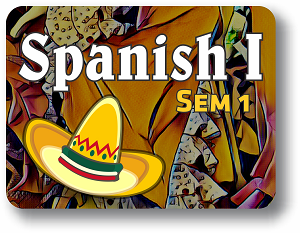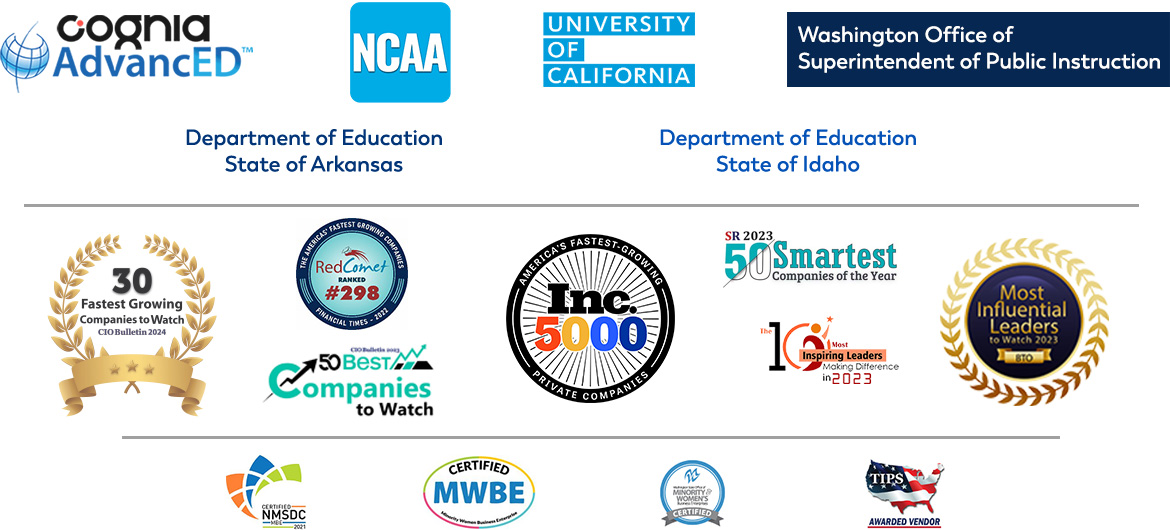Course Overview:
In this beginning Spanish 1 course, students will be introduced to the Spanish language and culture and build a strong foundation for their Spanish language learning journey. Students will learn the fundamentals of Spanish grammar, including how to determine the gender and number of nouns and articles, how to use possessive and descriptive adjectives in Spanish, how to use regular and irregular verbs in the present tense, and how to use regular and irregular verbs in the informal future tense. In addition to developing strong foundational grammar skills, students will be introduced to various high-frequency vocabulary, obtaining the necessary building blocks to start communicating about common daily topics in Spanish. Some of the vocabulary lists presented in this course include greetings and introductions, numbers 0-100, telling time, calendar, school/classes, asking questions, places, pastimes/hobbies, family members, descriptive adjectives, emotions, and likes/dislikes. Finally, in addition to teaching students beginning Spanish language skills, this course will also introduce them to the Spanish-speaking world, reminding students about the connection between language and culture. Through this course, the students embark upon a journey that will enable them to become more global citizens. They will soon be able to communicate with Spanish speakers worldwide.
Prerequisites:
Required Materials:
Headphones (good quality)
Computer or Device with working Microphone to record audio (Audio can be directly recorded from the course if your device has a working microphone.)
Additional Resources:
Textbooks:
Descubre 1 (Vista Higher Learning)
Realidades, Level 1 (Savvas Learning Company)
Websites:
www.quizlet.com - an interactive vocabulary practice website
- Create your own sets of vocabulary flashcards or search for a specific topic and study a set that has already been created
- Practice definitions with flashcards
- Practice writing terms (both English to Spanish and Spanish to English)
- Practice spelling terms by listening to the term and typing what you hear
- Take instantly-graded quizzes (multiple-choice, written, true/false, and matching questions)
www.spanishdict.com - online translation and conjugation website
- Search definitions of words from English to Spanish or Spanish to English
- Find great grammar tutorials/explanations
- Look up the conjugation of any verb in any tense
- Find examples of new vocabulary words in context to get a better sense of how they are used
Apps:
- Quizlet (see description above)
- Spanishdict (see description above)
- Duolingo - an engaging and interactive way to practice your skills!
- Works like a video game - Compete for points while expanding your vocabulary and grammar knowledge
- Tests all 4 skills - speaking, listening, reading, and writing
• Work at your own pace
• Get instant feedback and personalized practice (the app keeps track of which words you have mastered/miss frequently and gives you practice where you need it
Syllabus:
SECTION 1: Introduction to the Spanish Language
- Introduction to Spanish Language and Culture: Why Learn Spanish?
Objective(s): Students will learn the history and origin of the Spanish language; Students will learn the countries that make up the Spanish-speaking world; Students will recognize reasons to learn Spanish; Students will identify various professions that require proficiency in Spanish.
- Introduction to the Spanish Alphabet and Cognates
Objective(s): Students will identify similarities and differences between the pronunciation of the Spanish and English alphabets; Students will recognize cognates; Students will ask and answer questions about word meanings in Spanish and English using language ladders.
- Greetings and Introductions / Cultural Customs for Greetings in Spanish-Speaking Countries
Objective(s): Students will learn greetings and introductory conversation vocabulary in Spanish; Students will be able to complete and write introductory dialogues in Spanish; Students will understand cultural practices for greetings in Spanish-speaking countries.
- Numbers 1-30 and How Many?
Objective(s): Students will learn the following high-frequency words in Spanish: numbers 0 to 30, the interrogative words “¿Cuántos/as?”, and the verb form “hay”; Students will ask and answer questions to communicate how many (nouns) there are.
- The Spanish Calendar - Days of the Week, Months of the Year
Objective(s): Students will learn the following high-frequency words in Spanish: days of the week, months of the year, and calendar vocabulary; Students will learn to communicate about schedules in Spanish by asking and answering questions about what day it is.
SECTION 2: Spanish in Everyday Life
- ¿De dónde eres? (Where Are You From?)
Objective(s): Students will learn subject pronouns; Students will learn uses and conjugation of the verb SER; Students will learn how to ask/tell where people are from using SER + DE + COUNTRY; Students will learn capitals of Spanish-speaking countries.
- En la escuela (At School)
Objective(s): Students will learn vocabulary about classes/school subjects and the verb TENER (TO HAVE) to talk about their schedules; Students will review the days of the week; Students will learn vocabulary about common classroom objects in order to describe their classrooms; Students will review ¿Cuántos/as?, Hay, and numbers 0-30.
- Gender of Nouns and Articles
Objective(s): Students will learn definite and indefinite articles in Spanish; Students will learn rules for determining the gender of nouns and articles; Students will learn rules for pluralization of nouns.
- La hora (Time)
Objective(s): Students will learn vocabulary about telling time; Students will learn vocabulary about times of day; Students will learn the numbers 31-100; Students will review the numbers 0-30; Students will review vocabulary about classes; Students will be able to ask and answer questions about their school schedules (what time they have each class).
- ¿Quién eres? (Who Are You?)
Objective(s): Students will learn how to ask/tell their age in Spanish; Students will learn how to ask/tell their birthday in Spanish; Students will review the numbers 0-30; Students will learn vocabulary about identifying themselves and others (¿Quién?/¿Quiénes?); Students will review the verb SER; Students will learn how to ask/tell names; Students will review how to ask/tell where they and others are from; Students will be able to introduce themselves by sharing their name, age, birthday, and nationality.
SECTION 3: Who Are You, How Are You, and What Do You Do?
- Present Tense of Regular -AR Verbs
Objective(s): Students will learn a list of common regular -AR verbs in Spanish; Students will learn vocabulary to create sentences with regular -AR verbs; Students will learn how to conjugate regular -AR verbs in the present tense; Students will learn how to use regular -AR verbs in sentences; Students will learn how to form negative sentences in Spanish
- Forming Questions in Spanish
Objective(s): Students will learn the interrogative words in Spanish; Students will learn how to form questions with interrogative words; Students will learn how to form yes/no questions using statements and changing voice pitch; Students will learn how to form yes/no questions with inverted subject/verb word order; Students will learn how to form yes/no questions using tag statements; Students will learn how to answer yes/no questions affirmatively and negatively.
- ESTAR and Prepositions
Objective(s): Students will review subject pronouns; Students will learn uses and conjugation of the verb ESTAR; Students will learn the contractions “del” and “al” in Spanish; Students will learn vocabulary related to prepositions in Spanish; Students will learn vocabulary related to places in Spanish; Students will learn how to ask and answer questions about the location of nouns using the verb ESTAR and prepositions.
- Descriptive Adjectives
Objective(s): Students will review subject pronouns; Students will review the verb SER; Students will learn vocabulary related to descriptive adjectives in Spanish; Students will learn about gender/number agreement of nouns and adjectives in Spanish; Students will learn endings for different types of adjectives in Spanish; Students will learn how to describe themselves and others using the verb SER and descriptive adjectives.
- ESTAR and Conditions/Emotions
Objective(s): Students will review subject pronouns; Students will review the verb ESTAR; Students will learn to use ESTAR to describe conditions and emotions; Students will learn vocabulary related to adjectives of condition/emotion; CA: Students will review gender/number agreement of nouns and adjectives in Spanish; Students will learn to ask/tell how people are feeling in Spanish.
SECTION 4: Family, Free Time, and Future Plans
- Present Tense of Regular -ER/IR Verbs
Objective(s): Students will learn a list of common regular -ER and -IR verbs in Spanish; Students will learn vocabulary to create sentences with regular -ER and -IR verbs; Students will learn how to conjugate regular -ER and -IR verbs in the present tense; Students will learn how to use regular -ER and -IR verbs in sentences; Students will learn how to conjugate the irregular yo verb HACER and use it to ask what people do in Spanish.
- Possessive Adjectives and Family
Objective(s): Students will learn the possessive adjectives in Spanish; Students will learn how to use possessive adjectives in Spanish; Students will review gender/number agreement between nouns and descriptive adjectives in Spanish; Students will learn vocabulary related to the family members in Spanish; Students will learn how to use prepositional phrases to clarify to whom the possessive adjective “su” refers when it is unclear; Students will review the verb SER in Spanish.
- TENER Expressions and the Verbs TENER and VENIR
Objective(s): Students will learn the conjugation and uses of the verb TENER; Students will learn to talk about various conditions using TENER expressions; Students will learn the conjugation and uses of the verb VENIR; Students will learn to write about what they have to do and what they feel like doing every day in Spanish; Students will learn a list of helpful transition words.
- Pastimes and Hobbies
Objective(s): Students will learn vocabulary related to pastimes/hobbies in Spanish; Students will learn vocabulary related to sports in Spanish; Students will learn to ask/tell about hobbies/pastimes in Spanish; Students will learn the conjugation and uses of the verb GUSTAR (to like); Students will learn the Indirect Object Pronouns in Spanish; Students will learn how to use prepositional phrases to clarify the Indirect Object Pronouns “le” and “les”; Students will learn how to talk about what they and others like to do in Spanish using GUSTAR.
- The Verb IR and the Informal Future Tense
Objective(s): Students will review/reinforce vocabulary related to pastimes/hobbies in Spanish; Students will review/reinforce vocabulary related to sports in Spanish; Students will learn the conjugation and uses of the verb IR (to go); Students will learn to ask/tell about where they and others go using the verb IR; Students will review the contraction “al”; Students will review vocabulary related to the places in Spanish; Students will learn to communicate about what hobbies/pastimes they are going to do using IR + A + INFINITIVE (informal future tense).

